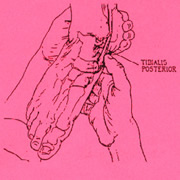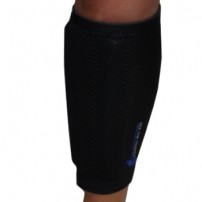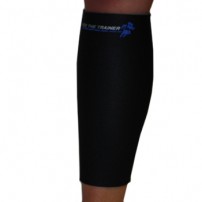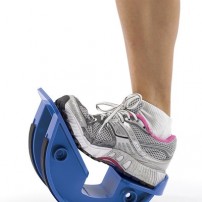Shin Splints

A “shin splint” is a catchall term used by coaches, trainers, and some physicians to describe an aching pain on the front of the lower leg. Shin splints occur most frequently to runners and running backs, but almost any running athlete is a candidate for this painful condition.
Shin splints are an early season phenomena. They happen mainly when your legs are out of shape. There are a couple of reasons why you could develop shin splints. One cause is overuse of the muscle that holds up your arch. About 75% of shin splints are due to this overuse. The other common cause is due to an irritation of the covering of the lower leg bone (periosteum). In certain folks, the force of the foot hitting a hard surface transmits irritation to the front of the shinbones. This, in turn, irritates the covering of the bone and produces pain. Both of these conditions show increased pain with activity and go away with rest.
Feel your shinbone, the bone in the front of your lower leg. As you move your hand to the inner part of your leg, you can feel where the muscle that holds your arch originates. The meat of this muscle forms a strong tendon that goes down behind the inner anklebone and attaches to the top of the arch. This tendon holds up the arch of the foot.
The pain results from over use of this muscle – the stress of exercise. Every time you put your foot down, the muscle strains to hold up the arch. In running a mile, you are stressing the muscle fifty to seventy times per minute for each foot. That is how many times your foot strikes the ground.
Treatment
The best early treatment is rest. You need to stop running or exercising for a week or so. Using the R I C E concept (Rest, Ice, Compression, Elevation) ice to the point of tenderness of couple of times a day for ten minutes. Wear some type of compression support like the neoprene sleeve with parallel buttresses for compression of the soft tissue on each side of the shinbone.
Strengthening
Theraband/Theratubing

Sit with your knee straight and your foot pointed down. Place a loop in the tubing and hang it over your toes. Tie the other end to a fixed object like a chair leg. Scoot back until the band has slight tension. Flex the foot back and toward to you at a fairly even pace. Do three sets to fatigue twice a day. Do one set until you feel like your muscle is tired. Rest for a minute then do a second set. Repeat a third set the same way.
Toe Raises

Stand with your feet parallel and the front of your foot on a 2” board. Keep your knees st
raight and simply raise your heels off the ground. Repeat as above.
Heel Raises

Stand with your heels on the same board and your toes on the floor. Raise your forefoot off the ground as far as possible, repeat as above.
You should do these exercises once or twice daily for at least one week prior to beginning running.
One Other Thing
An additional area of importance is to examine your arch. Remember, shin splints usually result from over use of the muscle that flexes the foot up and supports the arch. 95% of folks suffering from shin splits also have fallen arches.
Treatment
Treatment involves the use of some type of orthotic device. This can range from a sports insert to replace the one that came with the shoes, to a custom arch support that is made to fit your foot. Most likely, unless you have a need for a corrective custom arch support, the insert will do the job. Compared to the insert that came with the shoe, a sports insert has a rigid but flexible arch, a full length shock absorbing foot bed, a cupped and cushioned heel and an overall non-slip covering. The factory insert does not provide the features that are found in sports orthotics.
Even with the shoe correction, it takes time to heal the injury. You can start running at half-speed and half-distances and then increase, as you feel comfortable with it. With the proper arch support and strengthening exercises, you should not suffer this disorder again.


